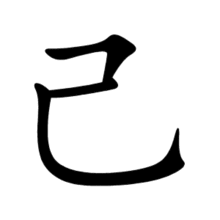| 己 | ||
|---|---|---|
| ||
| 己 (U+5DF1) "oneself" | ||
| Pronunciations | ||
| Pinyin: | jǐ | |
| Bopomofo: | ㄐㄧˇ | |
| Wade–Giles: | chi3 | |
| Cantonese Yale: | géi | |
| Jyutping: | gei2 | |
| Pe̍h-ōe-jī: | kí | |
| Japanese Kana: | キ ki / コ ko (on'yomi) おのれ onore / つちのと tsuchinoto (kun'yomi) | |
| Sino-Korean: | 기 gi | |
| Names | ||
| Japanese name(s): | 己/おのれ onore | |
| Hangul: | 몸 mom | |
| Stroke order animation | ||
 | ||
Radical 49 or radical oneself (己部) meaning "oneself" is one of the 31 Kangxi radicals (214 radicals total) composed of three strokes.
In the Kangxi Dictionary, there are 20 characters (out of 49,030) to be found under this radical.
己 is also the 52nd indexing component in the Table of Indexing Chinese Character Components predominantly adopted by Simplified Chinese dictionaries published in mainland China. Two associated indexing components, 已 and 巳 are affiliated to the principal indexing component 己.
In Chinese astrology, 巳 represents the sixth Earthly Branch and corresponds to the Snake in the Chinese zodiac. In the ancient Chinese cyclic character numeral system tiāngān, 己 represents the sixth Celestial stem.
Evolution
 Oracle bone script character
Oracle bone script character Bronze script character
Bronze script character Large seal script character
Large seal script character Small seal script character
Small seal script character
Derived characters
| Strokes | Characters |
|---|---|
| +0 | 己 (oneself) 已 (already) 巳 (6th Celestial stem) |
| +1 | 巴 |
| +4 | 巵 |
| +5 | 巶 |
| +6 | 巷 巸 巹 巺 (=巽) 巻JP (=卷 -> 卩) |
| +7 | 巼KO |
| +9 | 巽 |
Sinogram
The radical is also used as an independent Chinese character. It is one of the Kyōiku kanji or Kanji taught in elementary school in Japan.[1] It is a fifth grade kanji.[1]
References
- 1 2 "The Kyoiku Kanji (教育漢字) - Kanshudo". www.kanshudo.com. Archived from the original on March 24, 2022. Retrieved 2023-05-06.
Literature
- Fazzioli, Edoardo (1987). Chinese calligraphy : from pictograph to ideogram : the history of 214 essential Chinese/Japanese characters. calligraphy by Rebecca Hon Ko. New York: Abbeville Press. ISBN 0-89659-774-1.
- Lunde, Ken (Jan 5, 2009). "Appendix J: Japanese Character Sets" (PDF). CJKV Information Processing: Chinese, Japanese, Korean & Vietnamese Computing (Second ed.). Sebastopol, Calif.: O'Reilly Media. ISBN 978-0-596-51447-1.